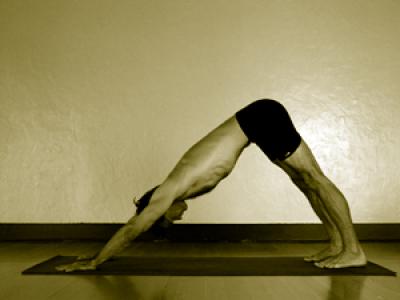Title
Adho Muckha Svanasana (Downward-Facing Dog)
Description
- Adho Mukha Svasanasa is a powerful, timeless teacher. It actively involves nearly every part of the body.
- It stretches the fingers, wrists, arms, shoulders, back, side, chest, hips, legs, ankles and feet.
- It strengthens most of the same parts of the body as well as the abdominals when one is cultivating ujjayi pranayama, mula bandha and uddiyana bandha.
- Press firmly into the entire span of your hands and length of your fingers, paying close attention to rooting the knuckle of the index finger as a way of balancing pressure in the wrist joint.
- Generally, the middle fingers should be parallel and in line with the shoulders. Look at see if your arms are parallel; this will indicate if your hands are in line with your shoulders.
- The alignment of the wrists with the shoulders allows the proper external rotation of the shoulders.
- Tight shoulders – especially limited shoulder flexion due to tight latisimus dorsi, pectoralis major and rhomboid muscles – and weak shoulders create specific risks to the neck, back, elbows, wrists and shoulders themselves. In either case, moderate effort in this asana develops both strength and flexibility, opening the shoulders to full flexion while developing deeper, more balanced strength.
- The shoulder blades should be rooted again the back ribs while externally rotating the shoulder joint, spreading the trapezius.
- Feet should be placed hip distance apart or wider with the outer edges of the feet parallel.
- Students with tight hips and hamstrings will find it difficult, painful and/or impossible to straighten their legs in this asana. Explore separating the feet wider apart and keeping your knees bent while moving into deepening your flexibility.
- Rooting into the balls of the feet will contribute to the lifting of the inner arches. This in turn helps to engage mula bandha (by activating the pereneus longus and tibialis posterior, which through fascial attachments help activates the hip adductors and pelvic floor muscles).
- Firming the thighs and pressing the top of the femur bones strongly back is a key action (along with rooted hands) in lengthening the spine in this asana. Resist any tendency to hyperextend your knees.
- With practice, the neck will become sufficiently strong and supple to keep the head between the upper arms. Until that strength and ease is developed, let your neck relax and head hang down.
- The first few times in the asana in any given practice, it can feel good and help the body in gently opening to “bicycle” the legs, dipping alternately into each hip and stretching long through the sides of the body while exploring the hamstrings, low back, shoulders, ankles and feet.
Photo
